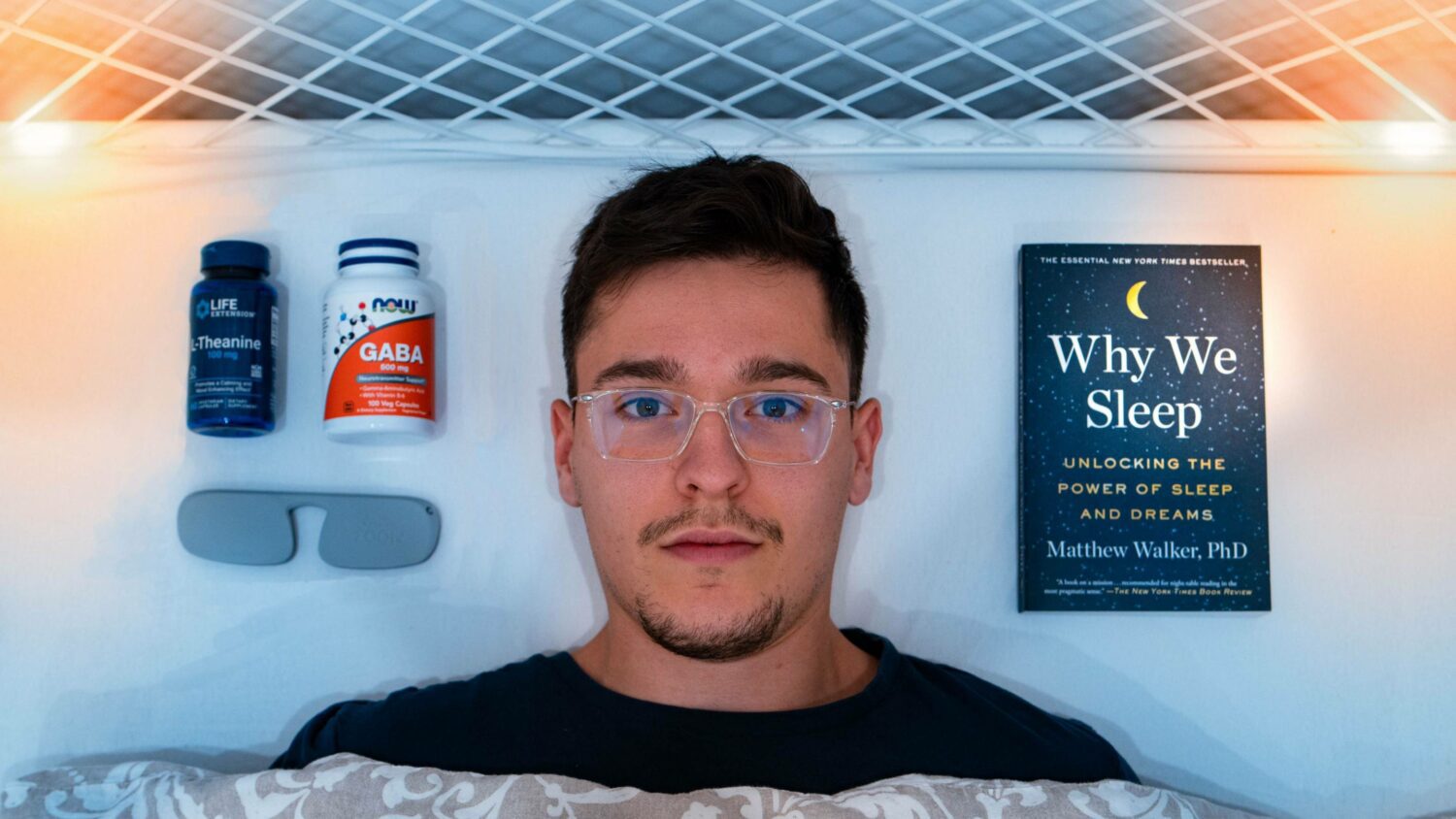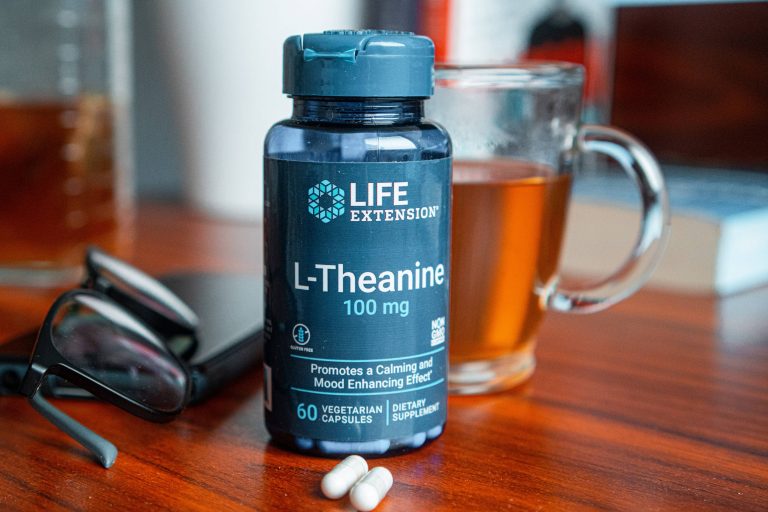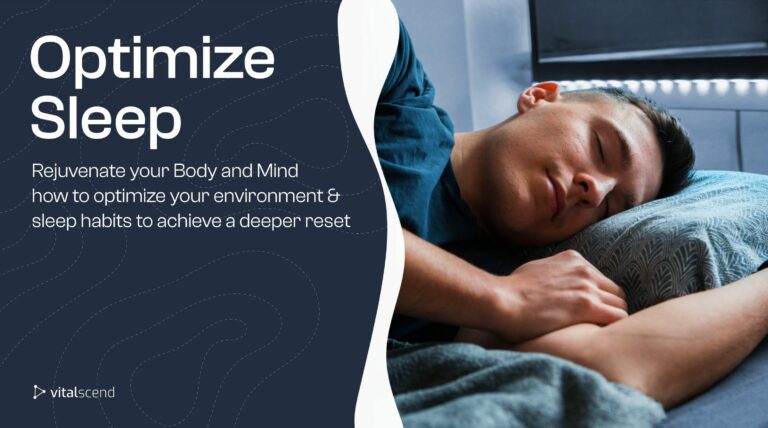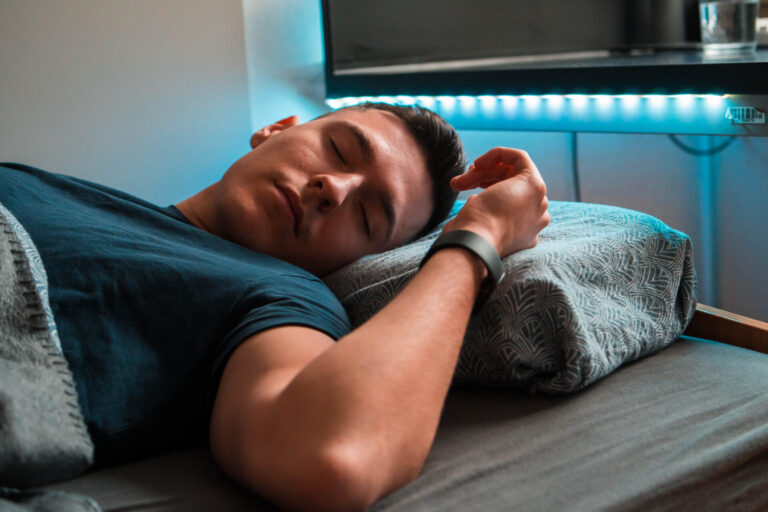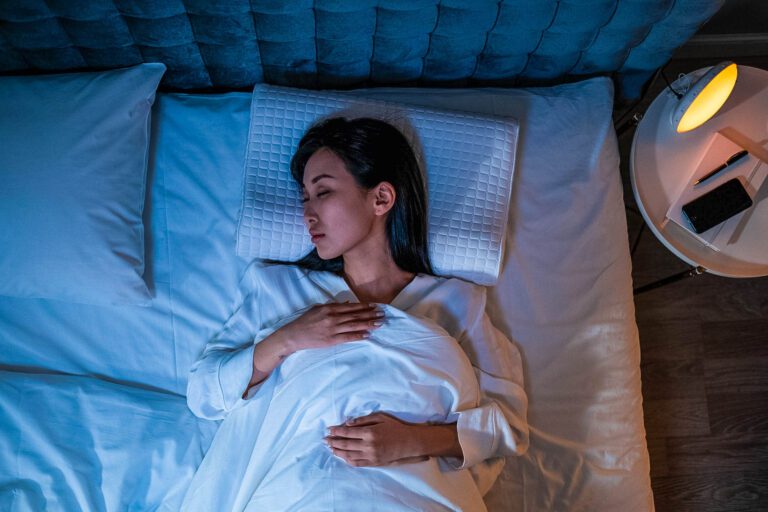7 Ways to Optimize Your Sleep Environment
To experience deep and restful sleep, we must optimize our sleep environment. With a few tweaks, we can give our body the right conditions for a deep reset. Besides many things we can do like cutting caffeine after 3 pm, sticking to a consistent sleep schedule, or practicing deep breathing, these things are easier. Once they’re set up, it’s game over, you don’t need to do anything.
Think back 1000 years ago. When the sun sets, it’s sleeping time, as it should be. However, with our tech-developed world, that’s kind of impossible. That’s okay, but we need to take control of our environment before it controls us. That means cutting blue light exposure at night, blocking noise, setting the temperature to cool, and much more. Enjoy!
The Biohacker’s Sleep Story
As the clock struck 11:00 PM, Emma knew it was time for her to get some rest. She had just finished setting up her newly optimized sleep environment, and she was so excited to see if it would make a difference.
She dimmed the lights and pulled the curtains shut, blocking out the last bit of light from the streetlights outside. As she settled into bed, she felt a cool breeze wafting over her from the open window. The white noise machine hummed softly, creating a comforting backdrop of sound that helped to drown out any noises from the outside world.
She looked over at the soft red light of the alarm clock and smiled, knowing that it was much less disruptive to her sleep than the bright blue glow of her phone. Her firm mattress provided just the right amount of support, and the pillows cradled her head perfectly. Emma closed her eyes, and for the first time in a long time, she felt completely relaxed and comfortable.
Emma felt like she was floating on a cloud, free from any worries or distractions. In her optimized sleep environment, everything was just right – the darkness, the coolness, the quiet, the red light, the firm mattress, and the white noise machine all working together to create the perfect conditions for a restful night’s sleep. Emma was already looking forward to waking up feeling refreshed and energized, ready to tackle whatever the day might bring.
Can poor sleep quality affect my overall health?
Yes, getting poor-quality sleep might hurt your general health. A weakened immune system, elevated risk of heart disease, obesity, diabetes, and mental health conditions including anxiety and depression are all consequences of sleep deprivation.
What are some natural sleep aids for improving sleep quality?
Some of the top natural sleep aids include relaxing techniques like massage, deep breathing, or meditation. In terms of supplements, l-theanine, chamomile tea, magnesium, and GABA may enhance one’s sleep.
What Is a Circadian Rhythm?
A circadian rhythm is a natural, 24-hour cycle that regulates various physiological processes in the body, including sleep and wake cycles. It is influenced by environmental factors such as light and temperature.
Benefits of Deep Sleep
Sleep is the natural way we reset our bodies. From flushing toxins out and reorganizing neural structures, to recovering muscle tissue and balancing hormones, it does it all. If you don’t believe this, think of a time you had to stay up studying for an exam. Felt like a zombie, didn’t you? Here are the benefits deep sleep promotes:
- Restoration of the body: The body goes through a process of restoration while in deep sleep, repairing damaged tissues and regenerating new cells.
- Immune system boost: By encouraging the creation of cytokines, which aid in the fight against infections and inflammation, deep sleep plays a crucial role in boosting the immune system.
- Regulation of hormones: Deep sleep is essential for the regulation of hormones, including growth hormone, which is crucial for muscle growth and repair.
- Enhanced brain function: Deep sleep is essential for consolidating memories, processing information learned during the day, and improving brain function.
- Improved physical performance: Research has shown that getting enough sleep helps athletes perform better in terms of endurance, speed, and response time.
- Lowered risk of chronic diseases: Deep sleep has been associated with a lower chance of developing chronic conditions like diabetes, heart disease, and obesity.
- Reduced stress and anxiety: By encouraging the synthesis of calming hormones and lowering the levels of stress hormones like cortisol, deep sleep can assist to reduce stress and anxiety levels.
conclusion
Sleep is a natural regenerative process that helps restore balance in the body. From hormonal homeostasis, brain function, and physical performance to lower risk of diseases, stress reduction, and immune system support, it does it all
7 Ways to Optimize Your Sleep Environment
Sleep in Dark Room
Light exposure greatly impacts our biological rhythm. Intuitively, people would fall into deep and restful sleep easier when it’s dark outside. Light increases brain activity making us awake and alert. It’s only when darkness creeps in that melatonin, the sleeping hormone increases to send us off to restful sleep. (1) (2)
The most important factor for boosting your sleep is controlling light exposure. At night, we can use blackout curtains, an eye mask, or pull the shades down, so the room is pitch black.
Our sleep-wake cycle is determined by the activity of the SCN or suprachiasmatic nuclei in the hypothalamus. The way SCN knows when it’s sleep time is by communicating with the light that penetrates through the retina. (3) The more artificial light around us the more awake we are. If it happens at night it causes circadian disruptions detrimental to sleep quality.
Fun Fact
Even exposure to dim light which is softer, at night leads to reduced total sleep time and efficiency in females, as well as decreased stage R latency. Cutting the light below 10 lux corresponded with an increase in REM or rapid eye movement sleep. (4)
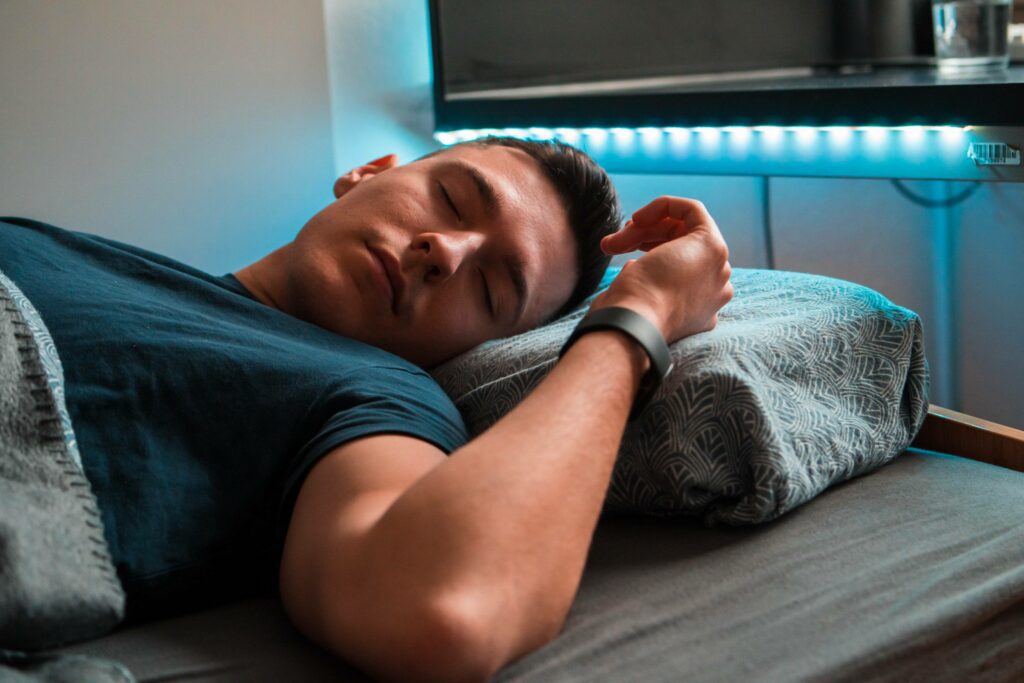
Sleep in Cool Temperature
The body’s temperature fluctuates in a narrow range within the 24-hour cycle. Core temperature is the highest at around 4-5 PM and the lowest at 4-5 AM when we’re in a deep sleep mode.
The ability to cool off is correlated with sleep onset latency. The more effective it is, the faster we can fall asleep. Keeping a cool bedroom allows your body to cool off easily, without needing to work hard.
The optimal temperature for sleeping seems to be around 60-67°F (15-19°C).
Drifting on to sleep and cooling body temperature happen in sync. Brain cooling is an important part of Non-REM sleep. (5)
Sleeping in a hot environment disrupts sleep more than traffic noise does. In 8 healthy participants, the 35° C with high noise levels was way more sleep-disruptive than sleeping at 20° C without noise. (6)
conclusion
Sleep latency and quality are associated with a lowering in body temperature. Once melatonin is secreted and we drift off to sleep, for sleep to be restful and deep it’s optimal to sleep at cooler temperatures like 15-19°C.
High-Quality Mattress
A comfortable and supportive mattress can mean the difference between a good night’s sleep and waking up feeling like you’ve just run a marathon. A firm mattress can help keep your spine in alignment and reduce the risk of back pain.
The most common question here is what type of mattress is better, firm or soft. While there are numerous theories, the research is quite clear. Moderate firmness. But there’s a catch. For different people, different firmness means moderate. That depends on factors like weight and muscle mass.
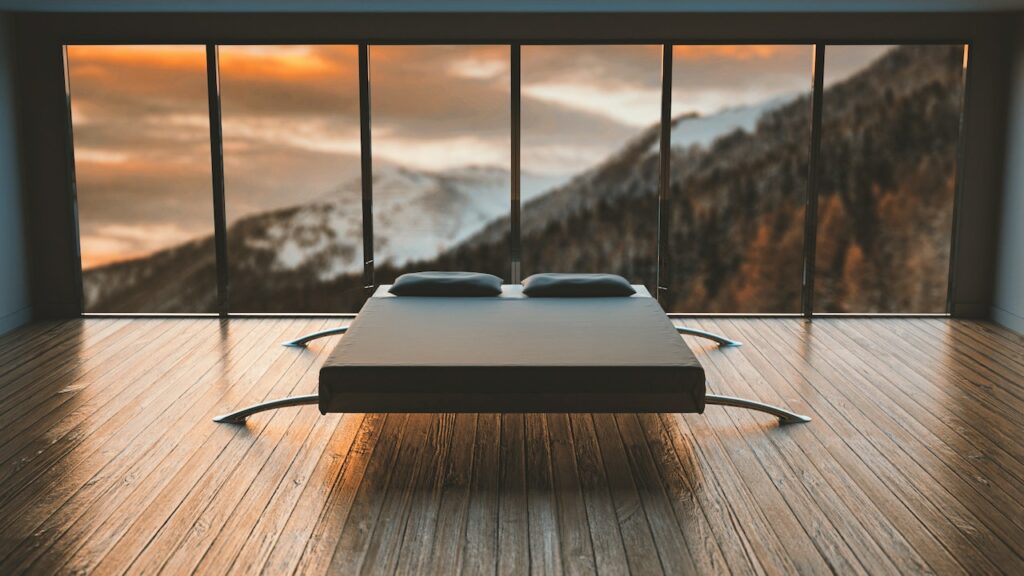
Here’s the research:
- Comparing soft, medium-firm, and extra-firm mattresses, the medium-firm promoted the most comfort, best sleep quality, and alignment. (7)
- A systematic review of 24 articles showed mattress firmness subjectively identified as medium, and self-adjusted was most optimal for alignment, comfort, and sleep quality. (8)
- In 40 adults, using P-VAS and PSQUI questionnaires, again the medium firm mattress was superior for a reduction in musculoskeletal pain and shorter time to fall asleep. (9)
Pro Tip
It’s about finding what firmness is medium for an individual. Subjective picks in many cases are rough estimates, but pretty spot on for most people. When sleeping, we shouldn’t completely sink into our mattress, but it also shouldn’t be wood-hard.
Use Essential Oils
Essential oils have been used for quite some time as they’re known to promote relaxation and calmness. You can add a few drops to your pillow or use a diffuser to fill your bedroom with the soothing scent of lavender, chamomile, or jasmine. Ah, the sweet smell of a good night’s sleep!
If you’re skeptical, let’s check the data, most of which highlights Lavender, as the secret aromatherapy weapon for deep, restful sleep.
- In 9 young and healthy participants, exposure to lavender aroma during sleep led to better sleep quality and higher vigor (energy) throughout the day. Delta wave during slow-wave sleep increased, again showing a slowing down of brain activity. (10)
- In 67 women between the age of 45-55, the use of lavender aromatherapy leads to better subjective sleep values and heart rate variability scores. Inhaling lavender stimulated parasympathetic activity, showing an inhibitory effect. (11)
- Aromatherapy using a combination of lavender, chamomile, and neroli at a 6:2:0.5 ratio lowered participants’ anxiety, and improved mood and sleep quality in patients in intensive care units. (12)
conclusion
It seems that aromatherapy, especially lavender can help us ease off to sleep. It slows down brain activity, may improve mood, and has shown positive outcomes on subjective sleep quality and energy.
Use Red Lights on Candles
The closer the sun, the more intense the light. Sunrises transition from yellowish to white, to UV, and then blue light. This is a shorter wave and stimulatory light. In the afternoon, the further the sun goes, the warmer the tones. From yellow to orange to red, finally a sunset. The warmer the tone, the longer the wavelength, the less stimulatory it is.
While blue light can wake you up in the morning, increasing your alertness at night disrupts your circadian rhythm. Being instead exposed to warmer tones at night like orange and red can help you sleep better.
Two ways to do this. Infrared sauna exposure is mostly used by athletes and for anti-aging, beauty, and cosmetic purposes. Or, you can switch up your bedroom lights with red-light bulbs so you’re less stimulated before sleep.
Research shows that red-light therapy for 14 days increased melatonin secretion and endurance performance in female basketball athletes. (13) Now you know why biohackers like to set up huge red-light panels in their home, huh?
Instead of using artificial blue lights, switching to ambient and red lights in the afternoon helps sync our circadian rhythm, potentially aiding in sleep quality. (14)
conclusion
Exposure to blue light at night disrupts circadian rhythm. One workaround is to switch to red light bulbs which won’t produce such a stimulatory effect, helping us drift off to sleep and secrete melatonin the darker the night gets.

Remove Electronics
In general, we’d want to stay away from Bluetooth, LED lights, WiFi, 5Gs, or any similar EMF-producing electronics. It’s been known that EMF pollution can disrupt sleep, increase fatigue, stress, brain fog, anxiety, and headaches. (15) (16)
It’s quite a challenge to quantify this. Partially because the rate of EMF exposure through our electronics isn’t as intense to show significant acute effects, as most research in lab settings lasts a few days. It’ll take years to see the effects.
Research in 34 young males showed no significant effects of sleeping next to a WiFi router, in terms of changing the architecture and macrostructure of sleep. (17)
In mice, it’s known that electromagnetic radiation from wireless signals can cause sleep disruptions that lead to negative health consequences. (18)
The mechanism behind EMF’s negative effect on sleep and health may come due to calcium overload in the voltage-gated calcium channels (VGCCs) in the brain. (16)
conclusion
Although not easily quantifiable, EMF and electromagnetic radiation like WiFi, 5G, and Bluetooth, may detrimentally affect sleep and circadian rhythm leading to negative health consequences.
Use a White Noise Machine
White noise can help to mask any unwanted noise and create a soothing and relaxing atmosphere. You can use a white noise machine or even a fan to create a gentle, steady background noise that can help to lull you to sleep.
The effectiveness of WNM is questionable, or at least you get a very individual response. If listening to the rain swiftly falling on your window helps you drift off to sleep, so can white noise.
It’s the rhythmic and predictable sound pattern that syncs with your brain frequency, letting you ease off to sleep. Pink noise is also an alternative, potentially beneficial for sleep. (19) (20)
If you already have a super-quiet environment, there’s no need for white or pink noise. But if you live in a busy city, white noise can actually prevent irregular sounds like car honks and storms from disrupting your sleep.
At least this was the case for New Yorkers. A study focused on 10 adults who lived in NYC, with high environmental noise. White noise improved both the measurable (objective) and self-reported sleep values. (21)
Conclusion
White or pink noise can block out unpredictable sounds that can disrupt sleep. It may help sync with the brain’s frequency, providing a predictable sound pattern that lets you drift off to sleep.
Elevate Your Sleep Hygiene
The key to leading a healthy, happy, and well-rested life is good sleep hygiene. It’s like giving your body and mind a warm hug and covering them in a comforting, peaceful blanket.
It’s about establishing a haven of calm in a chaotic and often overwhelming environment. You may turn your bedroom into a tranquil retreat where you can recharge your batteries and wake up feeling rejuvenated and ready to take on the world.
So why not create a haven for your body and mind in your bedroom? Start by choosing the ideal mattress and pillows to support your body as you sleep. Switch your lights to warmer tones, dim light, or install red light bulbs. To block out any obtrusive light, use blackout curtains or an eye mask. To block out any intrusive sounds, get a white noise machine.
Yet, the physical environment is only one aspect of good sleep hygiene. It also involves developing sound sleep practices, like relaxing before bed, abstaining from coffee and alcohol, and following a regular sleep schedule.
By prioritizing your sleep hygiene, you’ll be setting yourself up for a more joyful, productive, and fulfilling life. So, go ahead and create your own sleep sanctuary, and watch as your dreams become more vivid, your energy levels skyrocket, and your mood lifts to new heights. With good sleep hygiene, the sky’s the limit!
Conclusion
Optimizing your sleep environment is an efficient way to get the deepest and most restorative sleep. Once you set it up, maintenance is minimal. The most important factor is sleeping in a dark, cool, and quiet environment. Blackout curtains, a white noise machine, and an air conditioner can do the trick. The increased comfort from a medium-firm mattress can help with postural alignment, and reduce pain and stress. Removing electronics to block EMF radiation and blue light, and switching your lights to red or infrared at night can also greatly improve your sleep quality.

